The following set of images focuses on two public schools in Nakhon Si Thammarat Province, Thailand. The first one, Wat Phramahathat School, is located near Nakhon Si Thammarat City and the second one, Wat Khok Lek is in the Tha Sala district which is a rural area. Both schools follow the same educational program but this project was created with the intention of showing the economical difference between both geographical areas. The project also offers a sight of the strong connection between Buddhism and Thai people. About 95% of Thailand’s population is Buddhist. Images of this collection were taken on July 2014
-
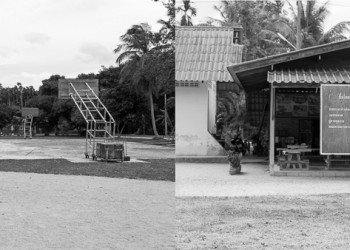
Wat Khok Lek School
Wat Khok Lek School is located in the Tha Sala district of Nakhon Si Thammarat Province, Thailand. It first opened on June 1st, 1939. Classes start at 8:50 a.m. and end at 3:30 p.m. with a lunch break at 11:00 a.m. Currently, there are a total 104 students enrolled. Out of the total number of students, 75 are in the nursery. One of the teachers at the school mentioned that schools closer to the city are usually “bigger and better”. She explained that the students who attend Wat Khok Lek are usually those whose parents cannot take to the city.
-
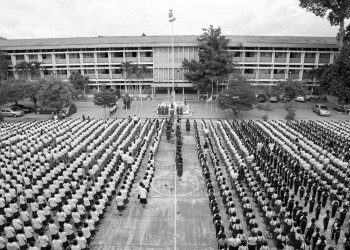
Wat Phramahathat School,
Wat Phramahathat School is located in the Nakhon Si Thammarat district, Thailand. It follows the same schedule as Wat Khok Lek School. It first opened its doors in 1921. There are currently 2333 students enrolled and 120 teachers.
-
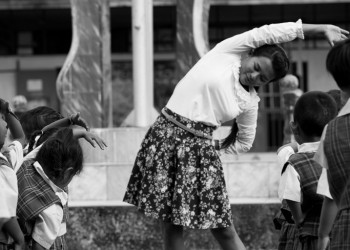
Baby PoMorning Stretchwder
Every morning at Wat Khok Lek, a song plays at 8:30 a.m. This lets the students know that it is time to line up on the school’s yard. After singing Thailand’s national anthem and praying, teachers guide students through some active stretch moves. Stretching, along with the music, helps the students exercise slightly. In addition, it helps to wake them up and improve their focus during their morning classes.
-

Baby Powder
Buddhist Monks used to provide education in Thailand (referred to as monastic education). However, the Thai government is now currently in charge of the educational sector.
-
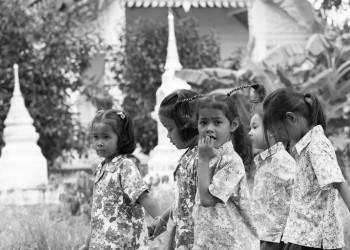
Temple Ground
Public schools in Thailand are Buddhist schools located on temple or “Wat” grounds. Today, Buddhism is the leading religion in Thailand. Every year, each school prepares a procession that leads specifically to their temple, which gave them the land to build their school. Ram Klong Yao is the name of the procession or service that leads to a Wat while students dance their way to the temple to the sound of drums. This procession always means a celebration. It is very common, especially in Southern Thailand.
-
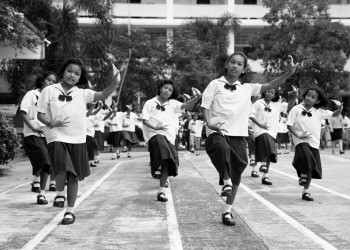
Ram Thai Dancers
Traditional Thai dance is considered the main dramatic art form in Thailand. It is classified into two forms: high art, which is a classical dance, and low art, which is a folk dance. In Ram Klong Yao, students perform a folkloric version of the dance. One of the main characteristics of the dance is the movement of hands and wrists. A dancer’s body should be in line constantly. Dancers stretch their fingers and wrists daily to improve flexibility.
-
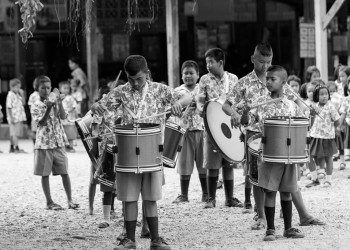
Tom Tom
While elementary school girls practice their traditional Thai dance moves, the older boys prepare the band that will lead the parade. The main instruments used are the ching (castanets), charb (small cymbals), grub (wooden clappers), mhong (bass gong), and tom tom (drums).
-
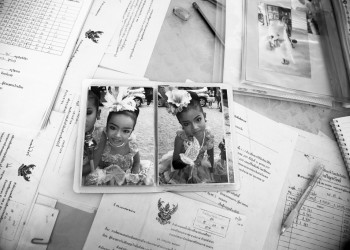
Ram Klong Yao Memories
Teachers and families gather around the temple and watch the procession during Asalha Puja Day. This holiday is celebrated on the eighth month of the Buddhist lunar calendar. This year’s festivity took place on July 18th. Asalha Puja Day, which is also known as the Candle Festival, is one of the most important Buddhist festivities. It is believed that the Lord Buddha gave his first sermon on that day. It is also believed that Lord Buddha’s sermon contains all the enlightenment of his following teachings. The day is dedicated to donating offerings to the temples and listening to sermons.
-
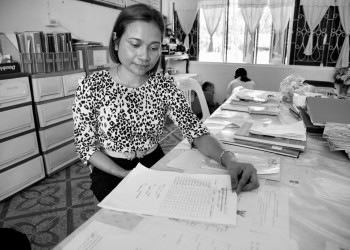
Miss Natnicha Chantamas
Tha Sala, Thailand. July, 2014. Miss Natnicha is one of the teachers at Wat Khok Lek. She explains that teachers at Wat Khok Lek School earn around 23,000 baht a month (about 720 USD). This is almost 4 times more than what she earned when she first started, which was 6,000 baht a month (around $188 USD). Miss Natnicha also earns an extra 3,500 baht a month (around $110 USD) because she has worked at the school for 10 years, and it will increase the longer she stays there. On the other hand, Wat Prahmahathat teachers earn an average of 30,000 baht a month (around $934 USD). Thailand’s current minimum wage is 300 baht a day (around $10 USD).
-
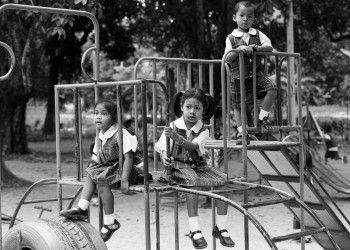
Wat Playground School
Pre-School education is for children from 3 to 6 years old; teachers in Wak Khok Lek refer to it as the nursery. Going to pre-school (level 1) is optional, but children must complete primary and secondary level. The Ministry of Education is responsible for providing what is necessary for educating Children in Thailand.
-
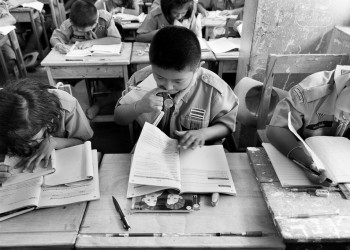
Prathom 5
After pre-school, children move up to primary school, level 2. It consists of 6 sub levels (P1 to P6) known as “Prathom.” Secondary school, level 3, is also known as “Mattayom.” Mattayom is divided into lower secondary and upper secondary (M1 to M6). After completing M3, students who wish to continue will take lower vocational education courses.
-
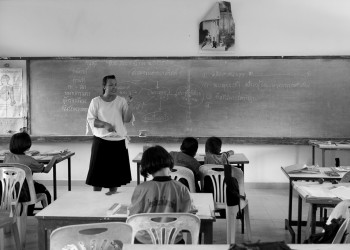
Miss Kanoyan Chuchot
Miss Kanoyan has been a teacher for 12 years at Wak Khok Lek and is currently teaching social studies. This subject covers Buddhism, politics, and civic engagement in Thailand. It is part of the public education curriculum of the country. The law requires parents to send their children to school a minimum of 9 years. Thailand’s Constitution guarantees a free basic education for 12 years.
-
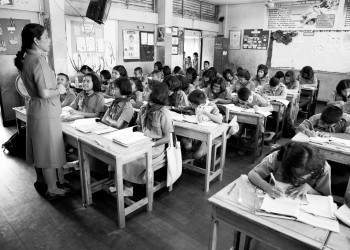
Classroom.
Thailand´s national curriculum has eight core subjects: Thai language, social studies, religion and culture, mathematics, science, health and physical education, arts, and foreign languages. The curriculum may be altered in order to include local culture without affecting the core subject standards. At Wat Khok Lek, students from P1 to P3 take 3 hours of English a week. After P3, students are only required to take 2 hours per week. On the other hand, Wat Prahmahathat students from P1 to P3 take 2 hours of English a week, but students from P4 to P6 take 4 hours per week..
-
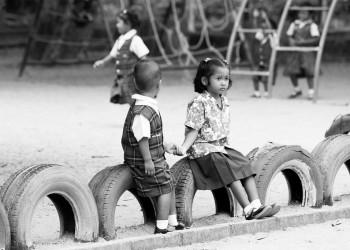
Morning Stretch
Every morning at Wat Khok Lek, a song plays at 8:30 a.m. This lets the students know that it is time to line up on the school’s yard. After singing Thailand’s national anthem and praying, teachers guide students through some active stretch moves. Stretching, along with the music, helps the students exercise slightly. In addition, it helps to wake them up and improve their focus during their morning classes.
-
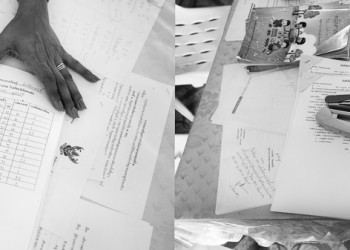
Grading System
Thailand’s grading system is based on a 0 to 4 scale, 0 being the lowest and 4 the highest. When students achieve an 80 percent or higher, they will obtain a 4.
-

Uniforms
Schools in Thailand require the use of uniforms. There is a standard model that does not vary much from one school to another. Kindergarten children usually wear red bottoms and a white shirt. Elementary and secondary grades uniforms for girls are a knee-length dark blue or black skirt with a white blouse that has a bow tie. Boys include knee-length shorts, which are usually khaki, dark blue or black with a short-sleeved shirt, long socks and dark shoes. Generally, uniforms have the students name and name of school embroidered on the shirt.
-

Thai Lunch
Students are able to purchase lunch at their school for 20 baht (around $0.60 USD). A traditional Thai lunch consists of rice, a type of meat and vegetables. Toddlers usually get milk and fruit as well.
-
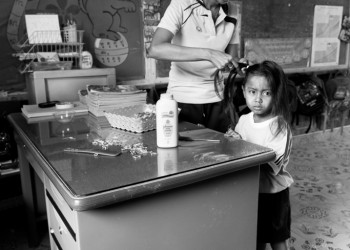
Post Nap
After lunch, students from the nursery take a nap. Teachers fix the children’s hair and put some baby powder on the toddler’s hands for them to apply it on their faces. Baby powder helps their faces stay fresh from the hot and humid weather; it keeps them from getting sticky skin during the excessive summer heat. Wat Khok Lek has an average of 25 children per classroom in the nursery and 10 children in primary levels.
-
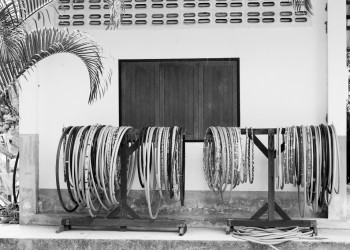
Hula Hoops
Thursdays are dedicated to sports, each grade has one hour of physical education. Teachers guide students through different sports like gymnastics, soccer, basketball etc. The incidence of obesity in Thailand is higher than other countries in the region, childhood obesity increased during the past years according to Thailand’s Ministry of Public Health. Some small-scale remedial programs have been initiated to fix the problem.
-
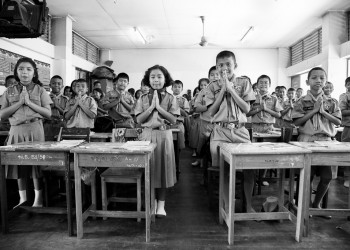
Sawadika
Sawadika means hello or greetings in Thai. This expression demonstrates the kindness of Thai people. Thai is the official language of Thailand and over 20 million people speak it. There are different variations of Thai spread throughout the country. In Nakhon Si Thammarat people speak Southern Thai- around 4.5 million people speak Southern Thai. Children are encouraged to greet teachers “sawadika” at the beginning of the class along with a wai. The wai expresses respect to teachers, elders or monks and it is encouraged to wai in return, one must wai when greeting and when saying goodbye.